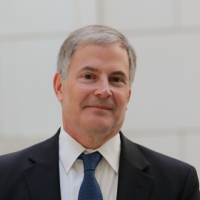WEBCAST | Bilateral Cooperation During the H1N1 Pandemic: Lessons from the US-Mexico Border
Quality of life in US-Mexico border communities is built not only upon commerce, tourism, and a host of comparative advantages but also on a network of diplomatic and epidemiological collaborative efforts to safeguard health at a community, regional, and national scale. Today, the outbreak and global spread of the COVID-19 virus is having a profound impact on health systems and on decisionmakers in both the United States and Mexico.
The two countries have faced pandemics before, including the H1N1 pandemic in 2009. In light of this, the Wilson Center's Mexico Institute was pleased to host a webcast event on bilateral cooperation during the H1N1 pandemic and how lessons learned can apply to the COVID-19 pandemic. Experts reflected on the importance of and best practices for cooperation during a public health emergency and how lessons from previous public health emergencies can improve readiness and resilience for future public health crises as a region.
Experts also discussed the Mexico Institute's latest publications on public health, Pandemics and Beyond: The Potential for US-Mexico Cooperation in Public Health and Crossborder Collaboration on Public Health: The 2009 US-Mexico Response to H1N1.
Selected Quotes
Erik Lee
“The H1N1 pandemic did not catch the US Mexico and Canada unprepared since the 2000s there was an intense focus on the possibility of pandemic. The SARS was a wakeup call for the three governments and a lot of planning went into a pandemic response. The first trilateral document was published in 2007 and then republished in 2012 with lessons learned.”
“What stood out for me from state officials was the complexities with working with very powerful bilateral and multilateral federal agencies and the creativity that is required to work with these organizations that have budget and power over how our border is managed.”
“Main lessons learned in the paper is the border functioned neither as a wall nor a membrane during the 2009 pandemic..."
"As an interesting contrast to 2020, the US and Mexican Federal governments never deemed it necessary to close the US border event partially, and that was an interesting aspect of 2009."
Leslie Bassett
“The record of collaboration and open communication that persisted through the experience, Mexico was completely transparent with the WHO and all the organizations that had at stake with the managing and messaging of the pandemic, they were generous in inviting experts and collaborating.”
“In the first few days of understanding that we were on the brink of a new experience of pandemic response, what I remember primarily was confusion and uncertainty. There was enough information for medical professionals to come forward and say ‘Here comes a big problem, and we should be taking drastic measures,’ but not enough to be able to share with the community the information they all wanted to know, like ‘What is the death rate? How do you transmit it?’...That uncertainty is compounded by the fact that medical professionals will tell you ‘No two pandemics are the same.’ They will not extrapolate from previous experience, and they will not give you timelines or other measures that need to be taken until they get scientific information and data.”
“Because of Mexico’s quick actions, it enabled the global response that essentially protected a much larger population of vulnerable people...Mexico was immediately transparent to the World Health Organization and the Pan American Health Organization, and all of the alphabet soup of organizations that had some stake in either the response or the investigation of the pandemic with management and messaging to communities about the pandemic...Because of Mexico’s openness, they both a more rapid investigation and assessment of the pandemic, of course, facilitated better treatment options, and ultimately extraordinarily rapid development of a vaccine.”
“I saw that [Medicaid in Mexico] was the Holy Grail in the paper that Andrew and Duncan wrote. There are still a lot of challenges and a lot of ways to improve, but that fundamental spark of the border being a rich opportunity for investment, for social collaboration, for cultural change hasn’t really changed. It’s still really vibrant and positive, and that the part that drew me back to it these many years later.”
Arturo Sarukhan
“You can’t cook up this type of collaboration if there isn’t institution building and trust that has been taking place over a significant period of time...the ability of Mexico and the United States to effectively, despite the huge challenge of the uncertainty and the moving terrain, to constructively address together, hand-in-hand, the H1N1 pandemic, was the result of taking advantage of what we had been building together as governments.”
“Communication, when we started understanding what was happening the collaboration of CDC and Mexican counterparts, communicating on a permanent basis with a density that is troubling to not see these days in the US Mexico bilateral relationship.”
“Governments should learn that you don’t discard stuff and mechanisms and protocols simply because there’s a new government in town. There’s a sense of building upon...these protocols of collaboration in what is the most complex bilateral relationship in the face of the Earth.”
“What you saw in the 2009 and the effectiveness that you saw in 2009 was something that has been evolving and has been built into the US-Mexico relationship. It’s unsexy many of the times: no big announcements, no photo-ops. It’s the hard day-to-day work between different institutions, agencies, bureaucracies on either side of the border that build this density in the US-Mexico relationship.”
R.J. Dutton
“Infectious diseases have been a concern in the US Mexico border since 1930. It’s almost 100 years of continuous interest on managing diseases on the US Mexico border.”
“The one important thing to mention about institutions is that after 9/11 there was an investment from the United States on preparedness. The government wasn’t necessarily expecting H1N1 but the ability to respond to the development of the vaccine and other needs were possible because the government was prepared.”
“Public health and the border aren’t often at the forefront of major bilateral discussions...[but] infectious diseases at the US-Mexico border have really been a priority since the 1930s, when I first saw documentation by Congressman Thomason of Texas, who introduced a bill that didn’t get passed, to address US Mexico Border Office for infectious diseases such as cholera, dengue, typhoid fever, tuberculosis. Some of these still persist...so you’ve got a span of 100 years of continued interest in infectious disease along the US-Mexico Border.”
“You don’t prepare for a pandemic in the middle of a pandemic, and whatever institutional building and relationship building you’ve done comes to the forefront, and that’s a very important issue.”
Andrew I. Rudman
"Health collaboration is one area where there is a great deal of unrealized opportunity."
“Our paper concludes with some recommendations, we recommend employing the full extent of what’s covered in NAPAPI and conducting an exercise of lessons learned. We propose clear coordination among regulatory agencies for pharmaceutical devices, integrating production when possible and cross border collaboration among governments and institutions to address human capital needs related to health.”
“First of all, it’s the recognition that an outbreak in one North American country can and soon will be an outbreak in all the countries. You can’t go this alone, you can’t wall yourself off from a pandemic. At the same token, you can’t manage it by yourself either. You’re going to get it as a region and you need to manage it as a region.”
“One of the opportunities in telemedicine is, if you think about bilingual patients or even predominantly Spanish-speaking in the US if there was a system and in fact there are companies offering this, where you have a doctor or a nurse based in Mexico or some other Spanish-speaking country that essentially does the telemedicine consults so that the person is speaking in their native language. It is both cost-effective and a lot more cost-effective and comforting to the patients.
Duncan Wood
“I hope in the aftermath of the pandemic we can go back and see how NAPAPI can be strengthened. In relation to human capital we need to think about the people, skilled workers and those in the medical profession, how do we prepare better in North America by using all the riches in the region.”
Speakers


Advisory Board Member, Mexico Institute, Wilson Center; Former Mexican Ambassador to the United States; Founder & President, Sarukhan + Associates

Introduction

Moderator

Hosted By

Mexico Institute
The Mexico Institute seeks to improve understanding, communication, and cooperation between Mexico and the United States by promoting original research, encouraging public discussion, and proposing policy options for enhancing the bilateral relationship. A binational Advisory Board, chaired by Luis Téllez and Earl Anthony Wayne, oversees the work of the Mexico Institute. Read more
